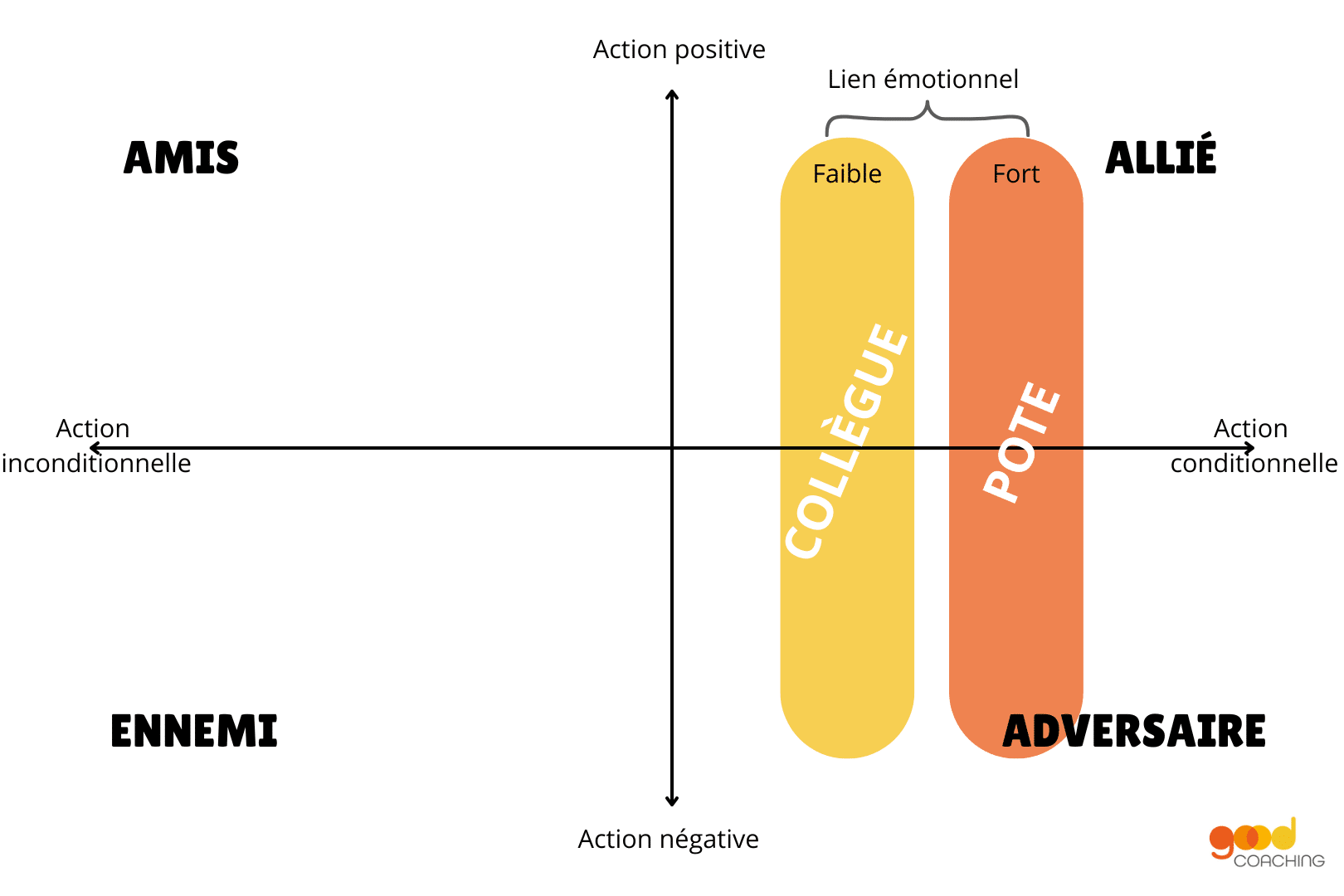A differentiated approach to diagnosing your relationships at work
“The beginning of wisdom is to call things by their names” – Confucius
We work with high-potential leaders who work as engineers, scientists, doctors, financial analysts… What these professions have in common is the need to make a thorough diagnosis before acting. Their companies provide them with the tools, resources and time to make these diagnoses in their technical fields.
Ironically, however, these same professionals often lack the means to diagnose their professional relationships. Does this scenario sound familiar?
“I thought Frederic was my ‘friend’: our families had dinner at each other’s houses and we played golf together. At the moment he’s getting in my way at the office. I feel betrayed. Frédéric is now my enemy.
Once a diagnosis of this kind is made, grains of sand will seize up a machine that was supposed to run smoothly.
We propose a new method of diagnosis.
On a two-axis matrix, we propose to our clients to position their professional relationships. The first step is to place the relationships in the right place on this continuum.
Unconditional relationships
- Friends
Our definition of friendship here is unconditional trust.
Friends at work don’t need organisational charts, bonus systems or job descriptions. True friends at work are rare. The world of work is shaped by circumstances and is results-oriented. It is a place where it is difficult to cultivate the flower of friendship. A former US president was probably right when he said of relationships in Washington, “If you want a friend, buy a dog”.
- Enemies
“Unconditional distrust” is our definition of enemies. You can count on them to act against your interests, no matter how you behave. They want you to leave the company or their direct circle and nothing else will do.
We consider friends and enemies to be in the relational category of the unconditional.
In a professional world that is often unpredictable, short-term and driven by the circumstances of the moment, the constellation of our professional relationships is constantly in flux. Enemies and friends, on the other hand, are our North Star.
Sometimes leaders cultivate enemies. At the highest level, the existence of powerful enemies adds spice, a clearer identity and coherence: Coca-Cola needs Pepsi, North Korea needs the US. Have you seen this phenomenon in your company?
The most difficult part of our work with leaders is to provide them with objective keys to understand that they have misdiagnosed an opponent as an enemy. We find that people have a hard time letting go of their enemies !
Conditional relationships
If friends and enemies are rare, allies and opponents are numerous. These are conditional relationships.
- Adversaries
Adversaries act against your interests to advance their own interests. If their interests change, adversaries can easily become allies. For example:
The sales manager and the industrial manager are often adversaries because of differences in their responsibilities and objectives. One is evaluated on the basis of turnover growth while the other is evaluated on the basis of his ability to produce reliable products at low cost. If you change the bonus system for both to aim for growth in the bottom line over a three-year period, you will see a positive change in the way they work together.
- Buddies
When opponents or allies have few emotional ties, they are called colleagues.
When adversaries or allies have positive emotional ties, they are called comrades or buddies.
The two CEOs of two competing companies go to the same golf club and enjoy playing together. Without telling anyone, they have each bought second homes in the same resort and take holidays at the same time so they can spend time together.
Allied buddies can very easily become adversaries if it suits them.
Four common mistakes in relationship management
Here are four relationship mistakes we see using our diagnostic approach:
- Confusing enemies with adversaries
One of the most difficult issues in relationship management is to distinguish between enemies and adversaries. This is difficult because enemies often masquerade as adversaries. For example:
For example: “Personally, I like Jeanne. I think Jeanne is very competent in her particular technical field, but…”.
Few enemies would be so direct as to say “I think you are a disaster for this company and I want you out. And nothing can change my mind”.
We find the following question useful in helping our clients sort out enemies from adversaries:
In the last 18 months, can you name an occasion when this person supported you or advanced your goals?
If the answer is “Yes, but they had personal reasons all along”, consider the person an opponent. If the answer is “No”, consider the person as an enemy.
By running the relationship through this filter, our clients have a framework for making a relevant sort. This sorting is critical. Once you have identified a person as an adversary you can focus on approaches to turn them into an ally.
Once you have identified a person as an enemy, their departure (or yours) is the only solution.
- Don’t default to thinking that every colleague is a buddy
The default relationship in business is that of buddies. Friends don’t stab each other in the back. Buddies will if it is in their interest. Buddies will if it is in their interest.
To differentiate between the two you need to test behaviour over time. For example, John has been made redundant and feels betrayed because two “friends” in the company no longer return his calls. In working with John we ask him what is the most important learning: that two people have let him down or that he has misdiagnosed two relationships?
- Try to turn enemies into friends
Do not waste time or political capital trying to make friends of your enemies. Enemies are still enemies. As we have said before, enemies give you spice, a clear identity and predictability in an uncertain world.
Leaders cannot avoid making enemies. And they can’t avoid dealing with them. If you have to deal with enemies, look at the allies around them and focus on them.
For example, Sophie was the director of a critical profit centre. She was both angry and depressed when she learned that the CEO had promoted her colleague, Peter, to the position of her n+1. She considered Peter an enemy and believed the feeling was mutual. Her hostility towards Peter was confirmed when she asked him how she could serve him better in the next 12 months. He replied, “First you prove yourself and then I’ll tell you.
Rather than working directly with Pierre, she made it clear to the CEO and COO that she was unhappy with the decision and interpreted it as a signal that she should seek opportunities elsewhere. She had calculated that they would prefer her to be on the company’s CODIR rather than that of a competitor.
Sophie was transferred to another division.
- Not cultivating allies
The biggest failure we see is neglecting our allies. Friends don’t need to stay in touch to stay friends. But allies have a contextual relationship. Don’t take their future support for granted.
We recommend a systematic approach of “Staying in touch” with the top 20% of your allies.
Set reminders in your calendar to contact your top 20% twice a year. A population of 200 contacts translates into 6-7 calls per month. These calls can be informal exchanges to ask how the person is doing. Don’t talk about yourself.
You don’t want your allies to say “She only calls me when she needs something”.
How do you decide who is in the top 20%?
If you are in marketing or sales, identify the people who are linked to your top 5 revenue sources over the last 12 months and 36 months. People who authorise purchases of products or services are directly linked to revenue generation. But it is also important to look at the allies who helped you get in touch with the primary sources.
Let’s assume you are not in a sales or marketing function. Look at your annual targets and their respective weights. Can you identify the internal people who contribute most to your success? These are your critical allies. Include them in your “Stay in Touch” programme.”
Synthesis
Many experts are very good at diagnosing technical business problems, but much less good at diagnosing relationships at work. A wrong diagnosis is like a stick in the wheels of an entity. Our tool helps to diagnose these relationships and manage them effectively.
Among the benefits: observing the reality of interpersonal relationships allows us to focus on the changes that depend on us rather than wasting energy by focusing on the behaviour of our enemies.
This article is based on ideas from Stybel Peabody Associates, Inc. Published on psychologytoday.com.




